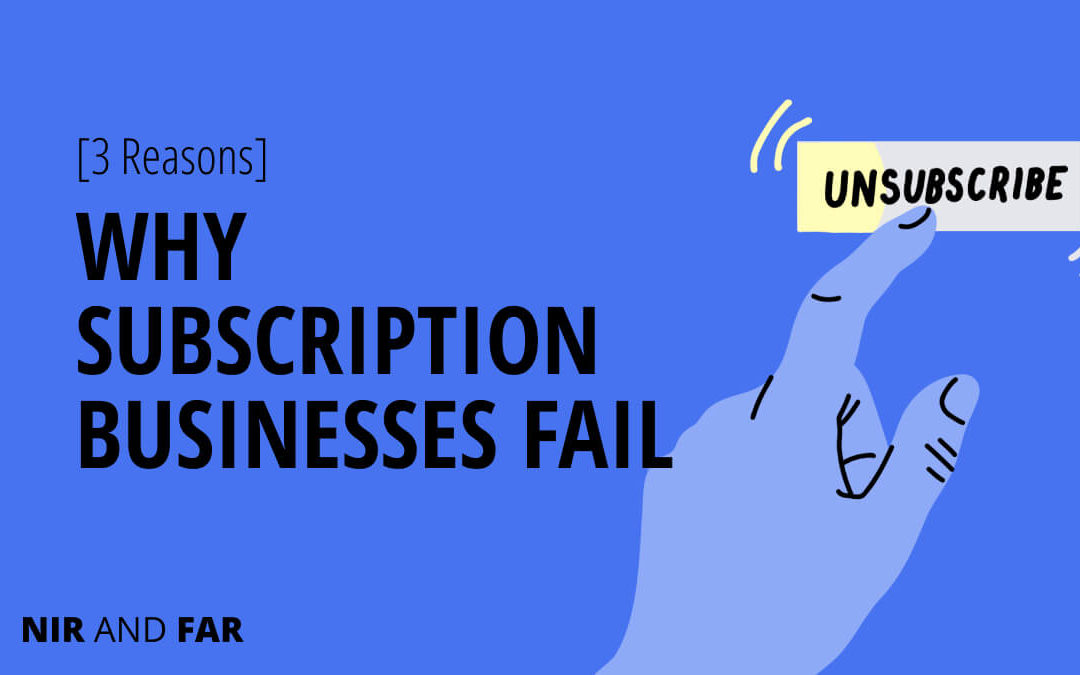Nir’s Note: This article originally appeared in The Harvard Business Review
Subscriptions are hot (and not).
Companies and investors love subscription business models since they generate recurring revenue that translates to predictable cash flow. The more money a company is likely to make in perpetuity, the higher its share price.
From 2012 to 2019, the subscription economy grew more than 300%, and 75% of companies selling directly to consumers said they would offer subscription services by the following year.
However, with so many companies hopping on the subscription bandwagon, competition is fierce, and some big players are having trouble keeping their customers. According to Gartner, “only 20% [of subscription businesses] will succeed in increasing customer retention.”
What’s causing the subscriber boom and bust? What makes an otherwise promising subscription business bleed customers? And how can companies engender loyalty to hold on to their subscribers?
Before we answer that, we have to pinpoint what a subscription business is.
More Than Recurring Revenue
A subscription is not defined by recurring revenue alone. Rentals, leases, and memberships generate recurring revenue, but none are subscription business models. So, what’s the difference? A subscription is when the customer pays for the future delivery of a good or service involving a degree of variability.
If you’re asked to name a subscription business off the top of your head, you might think of a magazine subscription. Subscribers pay an annual fee without knowing what articles they’ll read in the latest editions of Time or Harvard Business Review.
Many businesses call themselves subscriptions but aren’t exactly. Amazon’s “Subscribe & Save” makes for great alliteration, but shipping a predetermined item on a fixed schedule is a delivery service, not a subscription. Similarly, financing, leases, rentals, and monthly fees give customers access to a predictable good — a car, a home, or a tuxedo — so they’re not subscriptions either.
Fundamentally, a successful subscription business’s economic value is a function of the strength of the habits they create. Over the past decade, I’ve studied the fundamental attributes of habit-forming products to identify how companies hook consumers. I identified four steps successful companies build into their customer experience — what I call the “Hooked model”:
- Trigger (which prompts customers to use the product)
- Action (the habitual behavior)
- Variable Reward (which satisfies users’ need for the service)
- Investment (which makes the product more valuable to the user with use)
A closer look at the Hooked model reveals common errors companies make launching and running subscriptions:
1. Too Many Steps to Psychological Relief
Have you ever decided not to use Netflix because you know it’ll take too long to find something good to watch? I often waste more time searching than watching.
The endless scroll of options on today’s Netflix is a far cry from the mailed DVDs that originally made the company a success. The red envelope–wrapped disc simply needed to be opened and put into your player. No choices, no thinking—just watch what you previously picked. Netflix stole Blockbuster’s customers by busting the incumbent’s habit through ease of use.
When the habitual action of your product becomes more difficult to use than other options for satisfying the same need, your subscription business is in trouble. You’re at risk of losing consumers at the action phase of the Hooked model.
Today, it’s Netflix on the defensive. With so many entertainment options offering frighteningly swift dopamine boosts (think YouTube, TikTok, Instagram), Netflix can’t go back to the days when subscribers would play whatever came in the mail—but the endless choices came at the cost of simplicity.
Netflix is aware of this problem and is trying to simplify selecting a movie or TV show. The streaming service is experimenting with a “Play Something” function, quickly picking what to watch for viewers. However, this doesn’t quite hit the mark.
People don’t want to watch just anything. They’ve come to expect something good to watch. It’s telling that viewers are hacking their own solutions to fix this problem by using Chrome extensions to add critics’ scores to the site to make picking what to watch easier.
2. Not Offering Enough Novelty
Here’s the thing about humans: We’re not wired to feel satisfied for very long.
Our brains come pre-installed with a piece of mental software that makes us tire of the old and seeks out the new. It’s called “hedonic adaptation,” and it’s the reason lottery winners and paraplegics tend to eventually revert to the same levels of happiness they felt before their respective life-changing events.
Our tendency to quickly return to a baseline level of satisfaction leaves us vulnerable to the one supernormal stimuli we find hardest to resist: surprise!
Variable rewards make gambling engaging, television interesting, sports exciting, and social media habit-forming. People are insatiably curious and constantly looking for the new and better thing. On the flip side of the coin, they will stop paying for subscriptions that don’t offer perpetual novelty.
Consider the current “anything in a box” trend. From lingerie to bones to slime, you can pay to receive a box filled with just about anything these days. Some of these services, like the classic “book of the month club,” have been around for centuries. But many come and go quicker than you can say, “Why would anyone want to subscribe to bones in a box?”
A key reason customers churn out of subscription services is declining variability. After a few months, box subscription companies struggle to keep up the element of surprise for each delivery of socks or protein bars. When the ratio of interesting to mundane is too low, customers lose interest and find (usually cheaper) alternatives.
Thankfully, there is a way to boost the ratio of variability and sustain interest in the subscription service: getting users to improve the service with use, AKA the investment phase of the Hooked model.
3. Lack of Stored Value
Software as a service can be a very profitable subscription business. The gross margins on SaaS products are legendary, and companies selling habit-forming software for a monthly fee are rewarded with high valuation multiples.
Since their products are often free to try, SaaS companies have a competitive advantage over software requiring a high upfront cost. Acquiring new users is relatively easier with less friction in the way.
Keeping customers, however, is another story. Ask anyone working in SaaS to name their most important metric, the one that keeps them up at night, and they’ll tell you it’s customer churn. If you can’t keep your customers hooked, they’ll stop using and stop paying.
Many subscription services neglect the critical fourth step of the Hooked model, the investment phase. Here, the user puts something into the product that makes it better (and stickier) with use. I call this principle “stored value.”
Stored value can take many forms, depending on the type of service. Contributing data, adding content, accruing followers, making connections, and building a reputation are just a few examples of how subscribers can make the product more valuable over time. Many companies use the Hooked model to improve their subscription services with use.
Take Clockwise, one of my portfolio companies. The SaaS calendaring tool is used by big names like Airtable, Asana, and Atlassian — and that’s just working down the alphabetical list of the company’s 15,000 corporate accounts. Clockwise raised $45 million earlier this year and claimed its tool has “unlocked two million hours of focused work time.”
When used individually, the software learns the best times to recommend future engagements and time boxes. Francis Larkin, vice president of marketing at Clockwise, told me the tool adapts to the user’s energy levels and finds time for focused work. He also said, “We have a setting to help with Zoom fatigue, where we’ll automatically give you a break after two or three hours of back-to-back meetings.”
But the service really shines when it is used throughout the enterprise. “We absolutely see the most benefit when used across an organization because time is a shared resource,” Larkin said.
The more users invest in the service by inviting their colleagues and booking time on their schedules, the more visibility and flexibility each user has. Clockwise can seemingly make time by synchronizing schedules in ways not previously possible. It’s a classic network effect that stores value the more it is utilized, making the product more habit-forming and stickier with each pass through its Hooked model.
Better than Boxes
Subscription services are also making inroads into categories previously rife with failure.
Consider your morning cup of joe. If you subscribed to a coffee-bean delivery service, you’d likely enjoy it for a while, but as the novelty wore off, you’d probably cancel it—as many have with countless failed coffee-in-a-box subscription services.
Subscription services don’t win on unit price or quality alone. It’s almost impossible for subscription services to compete once shipping is factored in and you realize those beans cost more than the ones you could buy during your regular trip to the grocery store or are no better than those on sale at the third-wave coffee shop down the street.
But if the coffee subscription service had something unique to offer beyond price, you might stick around. For customers, stored value can justify paying a higher price and can keep them coming back.
Consider Bottomless Coffee. When customers sign up for a subscription, they receive a small, super-accurate Wi-Fi–enabled scale. The customer keeps the coffee on the scale, so the company “learns from your consumption and reorders for you at just the right time,” according to Bottomless.
In the case of Bottomless Coffee, the service ensures customers never run out of fresh beans. Instead of having to remember to buy or receive too much or too little or wait for delivery on a fixed schedule, Bottomless customers get precisely what they need, when they need it, as long as they keep subscribing.
Getting just-in-time coffee ensures it never gets stale. But collecting consumption data also helps Bottomless tailor future deliveries to customers’ tastes, thus storing value.
For instance, if Bottomless sees a particular coffee roast is being consumed quickly, it can infer that the customer enjoys it more and send a similar variety with the next shipment, giving the customer a variable reward from the novelty of a new roast and ensuring the selection is not too outside the customer’s taste preferences.
Bottomless plans to expand into all sorts of household products sent to consumers on their schedules and according to their preferences, not the company’s. By getting customers to store value in the service with use, Bottomless can potentially disrupt its industry by offering something non-subscription services can’t provide: personalization at scale.
By making the most of the Hooked model, subscription businesses can avoid the common pitfalls that cause customers to churn and build the kind of service customers enjoy for life.
Related Articles
- Schedule Maker: a Google Sheet to Plan Your Week
- The New York Times Uses the Very Dark Patterns it Derides
- How to Start a Career in Behavioral Design
- A Free Course on User Behavior
- User Investment: Make Your Users Do the Work
- Variable Rewards: Want To Hook Users? Drive Them Crazy
- The Hooked Model: How to Manufacture Desire in 4 Steps

